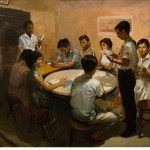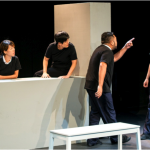“National Language Class”
Reviewer: Andrew Yuen
Performance: 22 January 2016
In National Language Class, the meaning and format of the play is established early on. The play’s programme guide resembles a school exercise book, and on the first page is a reproduction of the painting upon which the play is based. As I enter the doors of the City Hall Chamber, I am greeted by the same pastel yellow walls depicted in the painting. As we take our seats, the assembling audience is greeted by a character in the play, a student in white dress uniform. It is clear from the beginning that the border between audience and actor will be a hazy one.
The play exists within a historical present of sorts – the two characters exist within a classroom in the year 1959 and interact with an audience in 2016. It is based on the painting mentioned, and takes place as exchanges between the student, teacher and audience. Adorned on a blackboard is two central questions permeating the play: “what is your name?” and “where do you live?”
The play uses the two questions as a guiding motif. The teacher accosts the audience with the aforementioned questions, and the play is conducted as if we are students in the classroom (in the painting). The question is passed along the room, with each audience member answering with his or her name. Any form of audience participation triggers social anxiety, and yours truly began to sink two inches in his seat.
The performance builds into the typical call and response cadence of a typical classroom. We begin to repeat phrases in Malay to the teacher. I begin to grow frustrated. Why are my fellow audience members so quick to ‘play ball’?
The vocal miming ultimately becomes repetitive. It borders on being too kitschy, too precious. A more charitable, less cynical version of me will say that the very nature of the play has to function with repetition. It allows for a surreal communion between language, teacher and student. The teacher within the play uses a mix of odd miming – at one point he crouches, forming a peace sign with a hand extended. It is ultimately revealed that this odd gestures represent how sound travels, and how students learn a language. It is this very aspect of theatre that makes some lean forward and others to shift uncomfortably in their seats.
This brings me back to the meditation on what national language really is. Perhaps it isn’t something uttered, but performed. In the midst of the cadence of call and response from the audience, perhaps that language has been spoken.
That language is to remain seated.
Remain seated and be compliant.
Do you have an opinion or comment about this post? Email us at info@centre42.sg.
ABOUT THE PRODUCTION
NATIONAL LANGUAGE CLASS by Spell #7
21 – 24 January 2016
National Gallery Singapore, City Hall Chamber
ABOUT THE REVIEWER
Andrew Yuen is a freelance writer and photographer, whose interests lie in examining the relationships between art and society and how they affect the individual. He is fascinated by the creative processes of artists as well as art as a medium of communicative and creative expression.





